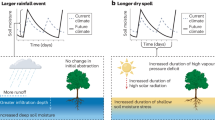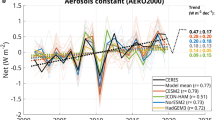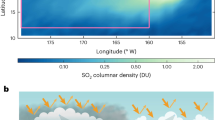Abstract
Recent measurements of atmospheric CO2 levels in ice cores1 have shown that global CO2 has increased by about 60 µmol mol−1 over the past 200 years. Evidence for the response of plants in the field to this change in CO2 levels is here presented in the form of a significant change in stomatal density—an anatomical response of considerable ecophysiological importance. A 40% decrease in density of stomata was observed in herbarium specimens of leaves of eight temperate arboreal species collected over the last 200 years. This decline was confirmed for some of the species observed as herbarium specimens by experiments under controlled environmental conditions. In these an increase in the mole fraction of CO2 from 280 μmol mol−1 to the current ambient level of 340 µmol mol−1 was found to cause a decrease in stomatal density of 67%. Experiments have shown that the combination of this previously unreported response of stomatal density to the level of CO2, with the known responses of stomatal aperture2, cause water use efficiency to be much lower than expected at low levels of CO2 and over a wide range of humidities.
This is a preview of subscription content, access via your institution
Access options
Subscribe to this journal
Receive 51 print issues and online access
$199.00 per year
only $3.90 per issue
Buy this article
- Purchase on Springer Link
- Instant access to full article PDF
Prices may be subject to local taxes which are calculated during checkout
Similar content being viewed by others
References
1. Friedli, H. el al. Nature 324, 237–238 (1986). 2. Zeiger, E. A. Rev. PI. Physiol. 34, 441–475 (1983). 3. Ticha, I. Photosynthetica 16, 375–471 (1982). 4. Korner, Ch. et al. Photosynthetica 13, 45–82 (1979). 5. Woodward, F. I. Oecologia 70, 580–586 (1986). 6. Salisbury, E. J. Phil. Trans. R. Soc. B216, 1–65 (1927). 7. Cowan, I. R. & Farquhar, G. D. in Integration of Activity in the Higher Plant (ed. Jennings, D. H.) 471–505 (Society for Experimental Biology, Cambridge, 1977). 8. Paleg, L. G. & Aspinall, D. Biochemistry and Physiology of Drought Resistance in Plants (Academic, London, 1981). 9. Madsen, E. Acta agric. scand. 23, 241–246 (1973). 10. Thomas, J. F. & Harvey, C. N. Bot. Gaz. 144, 303–309 (1983).
Author information
Authors and Affiliations
Rights and permissions
About this article
Cite this article
Woodward, F. Stomatal numbers are sensitive to increases in CO2 from pre-industrial levels. Nature 327, 617–618 (1987). https://doi.org/10.1038/327617a0
Received:
Accepted:
Issue Date:
DOI: https://doi.org/10.1038/327617a0
This article is cited by
-
Interactive effects of elevated CO2 with combined heat and drought stresses on the physiology and yield of C3 and C4 plants
Journal of Crop Science and Biotechnology (2023)
-
The intrinsically disordered region from PP2C phosphatases functions as a conserved CO2 sensor
Nature Cell Biology (2022)
-
Can the extinction risk of Irish vascular plants be predicted using leaf traits?
Biodiversity and Conservation (2022)
-
Transgenerational effects of elevated CO2 on rice photosynthesis and grain yield
Plant Molecular Biology (2022)
-
Interaction of elevated CO2 and form of nitrogen nutrition alters leaf abaxial and adaxial epidermal and stomatal anatomy of wheat seedlings
Protoplasma (2022)
Comments
By submitting a comment you agree to abide by our Terms and Community Guidelines. If you find something abusive or that does not comply with our terms or guidelines please flag it as inappropriate.



